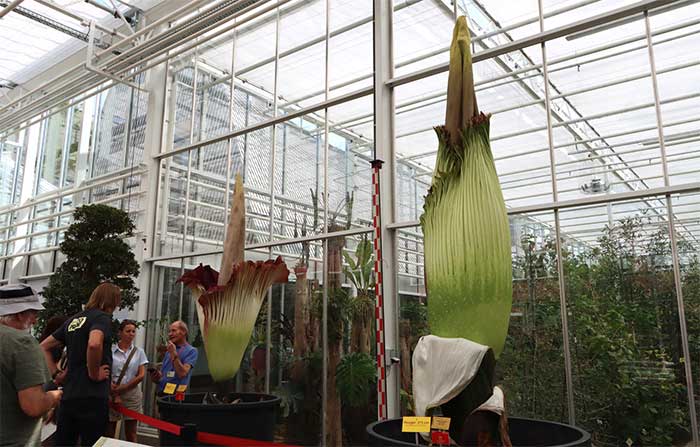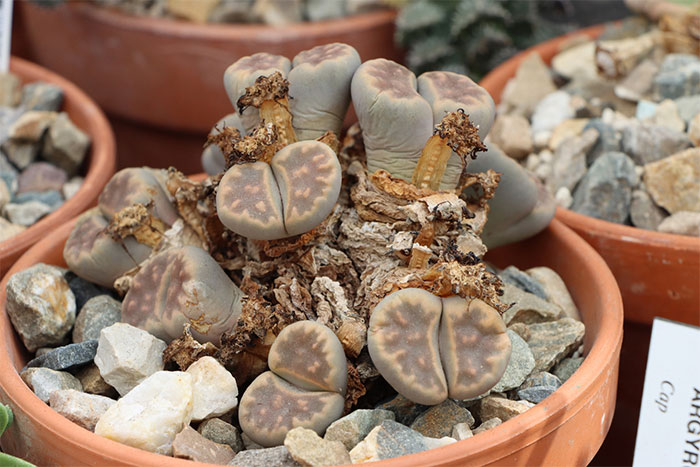Meise Botanical Garden: Home to rare plants
Founded 200 years ago, the Meise Botanical Garden (near Brussels, Belgium) with an area of 92 hectares is one of the largest and oldest botanical gardens in Europe.

Tourists enjoy learning about the giant flower Arum titan.
With more than 10,000 rare plant species, many of which are at risk of extinction, this place is not only a living museum of the history of plant development but also a scientific research center, contributing to the conservation of the planet's biodiversity.
Located in the heart of the Meise Botanical Garden , the Green Dome emerges as an architectural masterpiece, harmoniously combining aesthetic beauty and scientific functionality. Inaugurated last May, this is not just a simple greenhouse but also a miniature ecosystem, designed to simulate the natural habitat of tropical plants.
With a modern air conditioning system, automatic irrigation system and controlled lighting, Green Dome provides all the necessary conditions for plants to grow and thrive.
Conservation and Research Center

A type of living stone.
Leading us to visit the Green Dome, Mr. Marc Reynders, a biological engineer who has been associated with the Botanical Garden for more than 10 years, said that the Green Dome is considered the real "heart" of the collection of frost-sensitive plants, with all the space and necessary techniques, providing all the optimal conditions for the care and conservation of rare plant species.
The orchid growing area impresses with brilliant orchids like precious gems, shining among the green leaves. Orchids have always been one of the most beloved and collected plant families in the world. At Green Dome, visitors can admire many rare orchid species with unique shapes and colors, such as slipper orchids, phalaenopsis orchids, and gem orchids.

Area for conservation and propagation of lithophytes.
What is impressive here is that visitors can find famous carnivorous plants such as Venus flytraps, pitcher plants, and sundew plants. Venus flytraps close their traps when insects land on them. This is a special group of plants that can catch and digest insects to supplement their nutrition.
In the cactus and succulent area, many plants have strange shapes and bright colors. There are cacti growing tall in the sun and wind, bringing the wild beauty of the desert.
Several species of ancient trees, hundreds of years old, are also preserved at the Meise Botanical Garden. These ancient trees are not only valuable biologically, but also have historical and cultural significance.

Cactus varieties.
The Green Dome is equipped with the most modern technology in water and climate control , helping to create an ideal living environment for plants. Rainwater harvesting systems, sunshades and heat shields not only help save energy but also ensure a stable water supply for plants, even during long droughts.
' With the construction of Green Arch, we have made an important step towards our goal of becoming a climate-neutral botanical garden by 2045. Not only that, Green Arch is also a prime example that combining nature conservation and modern technology is completely feasible,' said Marc Reynders .
In addition to the Green Dome, the Botanical Garden also houses a state-of-the-art seed bank , which stores millions of seeds of rare plant species. This seed bank acts as a valuable genetic repository, helping to protect plant species from extinction. Together with the Green Dome, the seed bank forms a comprehensive conservation system, ensuring the survival of biodiversity and providing solutions to food security challenges.

Area for conservation and development of Arabica coffee varieties.
Scientists at the Botanic Garden are working hard to develop new varieties of plants that are disease-resistant, drought-tolerant, and adaptable to climate change. By studying wild relatives of coffee and bananas, for example, scientists hope to create new varieties of plants with higher yields and better quality, helping farmers cope with climate change and disease.
Propagating giant flower Arum titan

Propagating titan arum flowers.
What makes Meise Botanical Garden special is its comprehensive conservation program for the giant flower Arum titan (Amorphophallus titanum). The titan arum is native to the humid tropical forests of Sumatra, Indonesia. However, forests are disappearing at an increasing rate. By 2023, the world will have lost 3.7 million hectares of primary tropical forest, the equivalent of 10 football fields every minute.
As such, the titan arum is critically endangered in the wild. Its forest habitat is being cleared for timber and to make way for palm oil plantations. The Meise Botanical Garden therefore plays a vital role in preserving this species from extinction.
The titan arum, also known as the "giant corpse flower" , is one of the largest flowering plants in the world. This flower has very special characteristics that make it famous and attract the attention of many people. When blooming, the titan arum flower can be up to 3 meters tall or more, with a large purple flower surrounding a column of pale yellow flowers in the middle.

Seed bank at Meise Botanical Garden.
The most prominent feature of this flower is its very unpleasant scent, like the smell of rotting flesh. This scent attracts insects to pollinate the flower and is a smart survival mechanism of this plant. The stench attracts insects such as flies and beetles to pollinate. When these insects are attracted to the scent and fly to the flower, they will accidentally bring pollen from other flowers, helping the plant to pollinate and produce seeds.
With its enormous size and vibrant colors, the Titan Arum flower is a very unique flower and attracts the curiosity of many people. The Titan Arum flower only blooms for 48-72 hours, after which it will fade and the plant will return to its dormant state. This special event is also an opportunity to raise awareness about the threats to this rare plant species.
Scientists here are constantly researching the biological and ecological characteristics of this flower species, thereby providing the most appropriate care methods. By applying advanced breeding techniques, scientists have succeeded in breeding and creating many generations of healthy seedlings.
One of the most significant achievements of the conservation program was the successful artificial pollination of the Arum titan flower . This process required meticulousness and precision, but the results have brought new hope for the conservation of this rare flower. Thanks to this, the botanical garden has been able to increase the number of Arum titan individuals in its collection and share them with other botanical gardens around the world.

Orchid varieties area.
As a photographer at the Meise Botanical Garden, Maarten Strack van Schijndel has had a rare privilege: to explore every corner of the Green Dome. It is in this special space that he has captured extremely precious moments, especially when the titan arum flower blooms. These photos not only possess scientific value but are also unique works of art, helping people around the world admire the magical beauty of nature.
The Meise Botanical Garden is not only a scientific research center but also an ideal educational location. Through tours, presentations and practical activities, the Botanical Garden contributes to raising public awareness of the importance of biodiversity protection.
- Rare and rare plants flower after three decades
- The most beautiful botanical gardens in the world
- The world's largest botanical garden on Oman desert
- The most lonely minnows in the world
- Store DNA from plants around the world
- Worldwide there are more than 60,000 tree species
- Extremely rare plants 100 years new flowering and then die
- Two scavengers blooming at the same time in America
- Poison Garden - The world's deadliest garden
- People line up to see the most aromatic flowers in the world
- Hurry up, you only have 24 hours to witness the sight of flowers of the scavengers
- Discovering more than 250 rare and precious plants
 Norway built the world's tallest wooden tower
Norway built the world's tallest wooden tower Kremlin
Kremlin Ashurbanipal: The oldest royal library in the world
Ashurbanipal: The oldest royal library in the world Decoding the thousand-year construction of Qin Shihuang shocked the world
Decoding the thousand-year construction of Qin Shihuang shocked the world The flower looks like a devil's jailor, just looking at it is scary.
The flower looks like a devil's jailor, just looking at it is scary.  Thousands line up to see 'corpse flowers' in Australia
Thousands line up to see 'corpse flowers' in Australia  Flower species thought extinct for 40 years suddenly grows on the road
Flower species thought extinct for 40 years suddenly grows on the road  Discovered wild flowers thought extinct 40 years ago in Ecuador
Discovered wild flowers thought extinct 40 years ago in Ecuador  The mystery that once made Charles Darwin a headache is solved after 140 years
The mystery that once made Charles Darwin a headache is solved after 140 years  Vietnam has a flower that 'steps out of a legend' that can change color 3 times a day, when withering is the most unexpected time.
Vietnam has a flower that 'steps out of a legend' that can change color 3 times a day, when withering is the most unexpected time. 